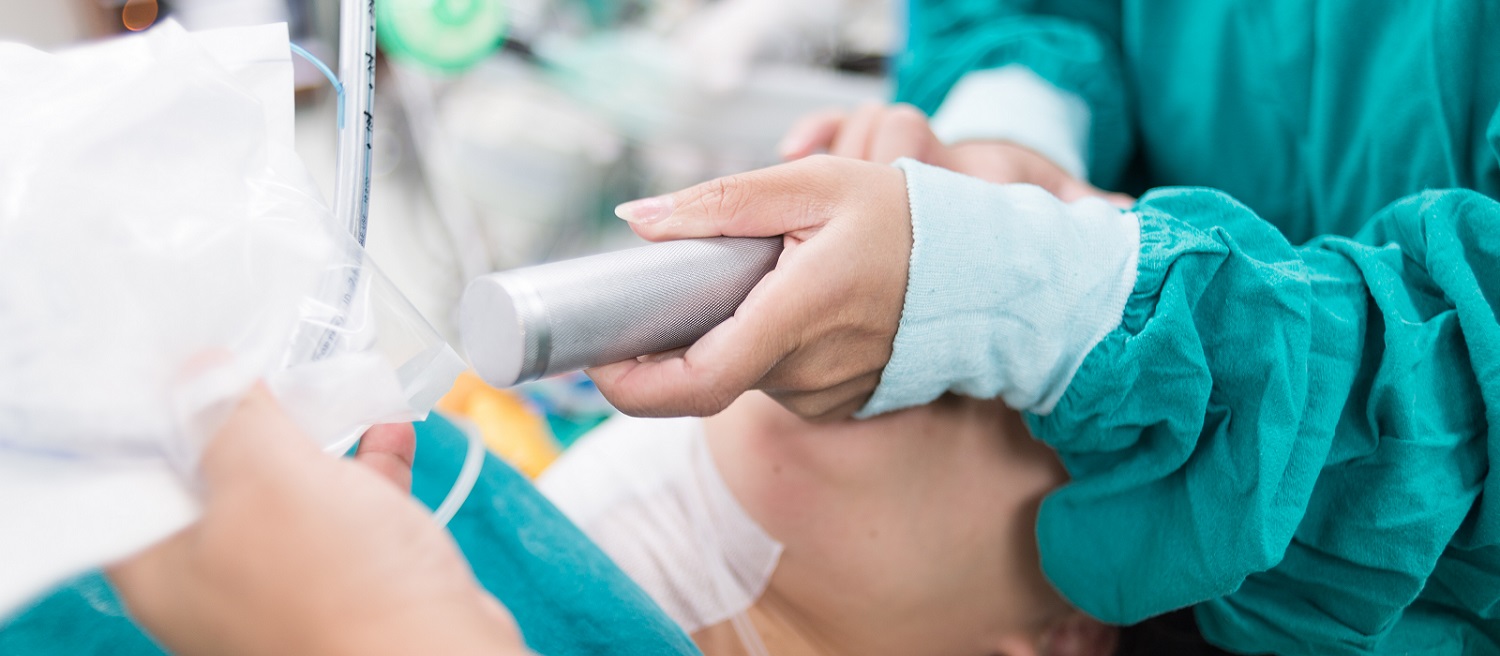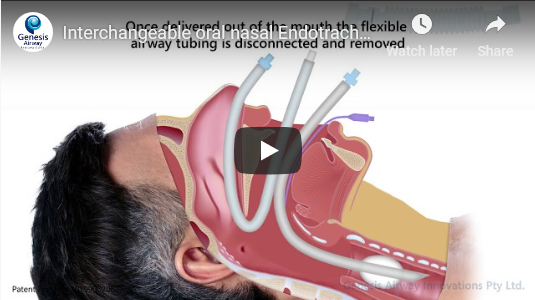
List of References
Innovations for simpler, safer and more secure airway management.
LIST OF REFERENCES
1. Sternbach G. Ivan Magill: Forceps for intratracheal anesthesia. J Emerg Med 1984;
1:543-545
2. O’ Hanlon J, Harper KW. Epistaxis and nasotracheal intubation – prevention with a vasoconstrictor spray. Ir J Med Sci 1994; 163: 58-60. Han
3. Holzapfel L, Chevret S, Madinier G. et al. , Influence of long term oro- or nasotracheal intubation on nosocomial maxillary sinusitis and pneumonia: results of a prospective, randomized, clinical trial. Crit Care Med 1993; 21:1132-1138
4. Michelson A, Kamp HD, Schuster B. Sinusitis in long term intubated, intensive care patients: nasal versus oral intubation. Anaesthesist 1991; 40:100-104.
5. Burruezo J, Navarro-Martínez J, Jiménez MA, Asensi P, Company R. Complete inferior turbinate avulsion after nasotracheal intubation. Rev Esp Anestesiol Reanim 2004; 51:177-179.
6. Cavusoglu 1, Yazici I, Demirtas Y, Gunaydin B, Yavuzer R. A rare complication of nasotracheal intubation: accidental middle turbinectomy. J Craniofac Surg 2009; 20:566-568.
7. Oomen AJ, Suvi M. An unusual reason for nasotracheal tube obstruction. J Case Reports Pract 2014; 2:60-61.
8. Goranovic T, Milic M, Knezevic P. Nasoendotracheal tube obstruction by a nasal polyp in emergency oral surgery. World J Emerg Surg 2007; 2:31.
9. Ng SY, Yew WS. Nasotracheal tube occlusion from adenoid trauma. Anaesth Intensive Care 2006; 34:6.
10. Krebs MJ, Sakai T. Retropharyngeal dissection during nasotracheal intubation. A rare complication and its management. J Clin Anesth 2008; 20:218-221.
11. Paul M, Dueck M, Kampe S, Petzke F, Ladra A. Intracranial placement of a nasotracheal tube after transnasal trans-sphenoidal surgery. Br J Anaesth 2003; 91:601-604.
12. Bannister CM, Kashab M, Dagestani H, Placzek M. Nasal endotracheal intubation in a premature infant with a nasal encephalocele. Arch Dis Child 1993; 69:81-82.
13. Sim WS, Chung IS, Chin JU, et al. Risk factors for epistaxis during nasotracheal intubation. Anaesth Intens Care 2002; 30:449-452.
14. O’Connell JE, Stevenson DS, Stokes MA. Pathological changes associated with short-term intubation. Anaesthesia 1996; 51:347-350.
15. Coe TR, Human M. The peri-operative complications of nasal intubation: a comparison of nostril side. Anaesthesia 2001; 56:447-450.
16. Seo KS, Kim JH, Yang SM, Kim HJ, Bahk JH, Yum KW. A new technique to reduce epistaxis and enhance navigability during nasotracheal intubation. Anesthesia & Analgesia 2007; 105:1420-1424.
17. Kim YC, Lee SH, Noh GH, et al. Thermosoftening treatment of the nasotracheal tube before intubation can reduce epistaxis and nasal damage. Anesth Analg 2000; 91:698-701.
18. Lee JH, Kim CG, Bahk JH, Park KS. The influence of endotracheal tube tip design on nasal trauma during nasotracheal intubation: Magill-tip versus Murphy tip. Anesth Analg 2005; 101:1226-1229.
19. Watanabe S, Yaguchi Y, Suga A, Asakura N. A “bubble-tip” (Airguide) tracheal tube system: its effects on incidence of epistaxis and ease of advancement in the subglottic region during nasotracheal intubation. Anesth Analg 1994; 78:1140-1143.
20. Sanuki T, Hirokane M, Matsuda Y, Sugioka S, Kotani J. The Parker Flex-Tip tube for nasotracheal intubation: the influence on nasal mucosal damage. Anaesthesia 2010; 65:8-11.
21. Sugiyama K, Manabe Y, Kohitani A.A styletted tracheal tube with a posterior-facing bevel reduces epistaxis during nasotrachael intubation:a randomized trial.Can J Anaesth 2014;61(5):417-22
22. Elwood T, Stillions DM, Woo DW, Bradford HM, Ramamoorthy C. Nasotracheal intubation: a randomized trial of two methods. Anesthesiology 2002; 96:51-53.
23. Watt S, Pickhardt D, Lerman J, Armstrong J, Creighton PR, Feldman L. Telescoping tracheal tubes into catheters minimize epistaxis during nasotracheal intubation in children. Anesthesiology 2007; 106:238-242.
24. Enk D, Palmes AM, Van Aken H, Westphal M. Nasotracheal intubation: a simple and effective technique to reduce nasopharyngeal trauma and tube contamination. Anesth Analg 2002; 95:1432-1436.
25. Ahmed-Nusrath A, Tong JL, Smith JE. Pathways through the nose for nasal intubation: a comparison of three endotracheal tubes. Br J Anaesth 2008; 100:269-274.
26. Morimoto Y, Sugimura M, Hirose Y, Taki K, Niwa H. Nasotracheal intubation under
curve-tipped suction catheter guidance reduces epistaxis. Can J Anaesth
2006;53:295-298.
27. Lim CW, Min SW, Kim CS, Chang JE, Park JE, Hwang JY. The use of a nasogastric tube to facilitate nasotracheal intubation: a randomized controlled trial. Anaesthesia 2014; 69:591-597.
28. El-Seify ZA, Knattab AM, Shabaan AA, Metwalli OS, Hassan HE, Ajjoud LF. Xylometazoline pretreatment reduces nasotracheal intubation-related epistaxis in paediatric dental surgery. Br J Anaesth 2010; 105:501-505.
29. Thrush DH. Cardiac arrest after oxymetazoline nasal spray. J Clin Anesth 1995; 7:512-514.
30. Chelliah YRT, Manninen PM. Hazards of ephedrine in transsphenoidal pituitary surgery. J Neurosurg Anesthesiol 2002; 14:43-46.
31. Smith JE, Reid AP. Identifying the more patent nostril before nasotracheal intubation: a comparison of nostril side. Anaesthesia 2001; 56:258-262.
32. Kayser R. Die exacte Messung der Luftdurchangigkeit der Nase. Arch Laryngol Rhinol 1895; 8:101.
33. Sanuki T, Hirokane M, Kotani J. Epistaxis during nasotracheal intubation: a
comparison of nostril sides. J Oral Maxillofac Surg 2010; 68:618-621.
34. Boku A, Hanomoto H, Hirose Y, et al. Which nostril should be used for nasotrachael intubation: the right or the left? A randomized clinical trial. J Clin Anesth 2014; 26:390-394.
35. Lim HS, Kim D, Lee J, Son JS, Lee JR, Ko S. Reliability of assessment of nasal flow rate for nostril selection during nasotracheal intubation. J Clin Anesth 2012; 24:270-274.
36. Smith JE, Reid AP. Asymptomatic intranasal abnormalities influencing the choice of nostril for nasotracheal intubation. Br J Anaesth 1999; 83:882-886.
37. Piepho T, Thierbach A, Werner C. Nasotracheal intubation: look before you leap. Br J Anaesth 2005; 94:859-860.
38. Abhiruchi Patki Laryngeal mask airway vs the endotracheal tube in paediatric airway management: A meta-analysis of prospective randomised controlled trial Indian J Anaesth. 2011 Sep-Oct; 55(5): 537–541. doi: 10.4103/0019-5049.89900
39. Patki,A. Effect of orientation of a standard polyvinyl chloride tracheal tube on success rates during awake flexible fibreoptic intubation PMID: 22174478 Anaesthesia,2006, 61, pages 845–848 doi:10.1111/j.1365-2044.2006.04750.x
40. Jafari A1, Gharaei B, Kamranmanesh MR, Aghamohammadi H, Nobahar MR, Poorzamany M, Shahrabi M, Solhpour A Wire reinforced endotracheal tube compared with Parker Flex-Tip tube for oral fiberoptic intubation: a randomized clinical trial. Minerva Anestesiol. 2014 Mar;80(3):324-9. Epub 2013 Oct 31.
41. Stephanie Lera*, Melissa Machan, George Derefaka A Safer Technique for Nasal Intubation: A Literature Review Open Journal of Anesthesiology, 2017, 7, 275-285 http://www.scirp.org/journal/ojanes ISSN Online: 2164-5558 ISSN Print: 2164
42. Thierry Boulain Unplanned Extubations in the Adult Intensive Care Unit
A Prospective Multicenter Study, American Journal of Respiratory and Critical Care
Medicine , and the Association des Réanimateurs du Centre-Ouest Vol. 157, No. 4 | Apr 01, 1998 https://doi.org/10.1164/ajrccm.157.4.9702083 PubMed: 9563730.

